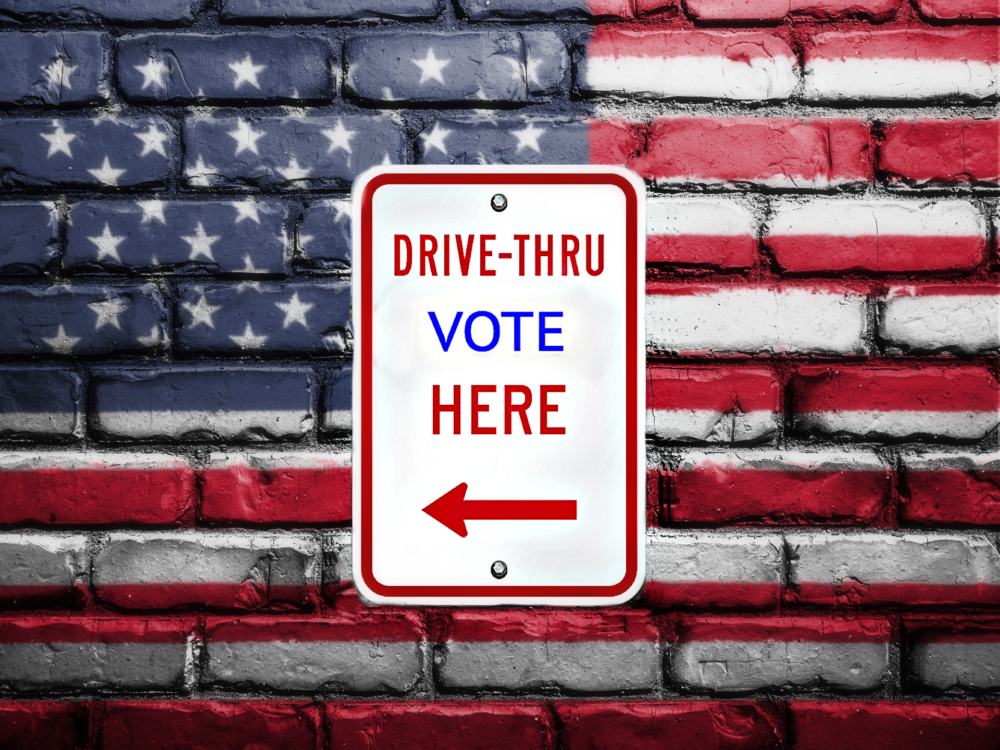In March, the first major domino of the coronavirus hit the U.S., causing thousands of schools, businesses, social and sporting events to shut down. Three hundred twenty-eight million Americans stood still in uncertainty, while over 50 million people lost their jobs, and over 100,000 small businesses shut down forever. In order to limit the economic fallout from this pandemic, the government signed the Cares Act, a policy that gave many Americans and businesses a spread of $2.2 trillion in stimulus checks, and many others were given unemployment benefits, too. The priority had/has been to help Americans financially and provide them safety and security during this pandemic. Although change and uncertainty have remained constant, as we approach November 3rd, 2020, one thing is certain, we will be having an election. Whether we wake up to re-elected President Trump or newly elected President Biden, the Presidential Election will take place in a unique fashion. Although the terms and outcome are yet to be determined, for the safety and security of the American people, this will be the year of the Drive-Through Democracy.
THE BACKGROUND:
For almost 200 years, Americans have typically voted privately at the ballot box at local schools or churches, etc. close to their homes. Still, with this being abnormal times due to COVID-19, two voting options have been brought forth as the default options to accommodate people’s safety and security for the 2020 Presidential Election.
One is Absentee Voting, and the other is Mail-in Voting. Absentee Voting has gone on for 200 years; it has traditionally been done for convenience to those serving abroad, the elderly who may not be able to stand in long lines, or for those who travel or are busy and can’t be present at their voting booths. The process for Absentee Voting is broken into four steps: 1) voters fill out a form, 2) request the official voting-ballot be sent to their home, 3) they receive and fill it out, and 4) mail it back via the postal office.
The second option of voting – which is newer – is Mail-In-Voting. Here, states automatically send the official ballots to voters at their residence. The difference between the two is that Absentee Voting requires voter-consent and paperwork via mail in order to receive their official voting-ballot. Whereas, compared to Mail-In-Voting, consent and paperwork are not needed. The process of sending in the official voting-ballot is direct and automated.
THE PROBLEM:
Currently, there isn’t a federal government requirement for states and their voters to have one or the other option. Still, as the election nears, all of the states are using a variation of mail-in and absentee voting and some in addition to physical Ballot-Box Voting. The main issue at hand for voting in this election is the legitimacy of the election results vs. public safety. Being in a pandemic-election cycle, and living in a more digitized society because of it, hundreds of millions of people will vote more cautiously and carefully than ever before and some with a great deal of skepticism. Of the 3 voting options – Absentee, Mail-in, physical Ballot-Box Voting – the question is which is the best option and how can the election be carried out safely and securely for the people, while also ensuring the results of the election are fair and accurate.
President Trump believes that Mail-In-Voting will likely lead to fraud. At the same time, most election experts, like Ohio Republican Governor Mike DeWine, say otherwise, stating that Mail-in Voting is the most flexible, common-sense, and safe and secure option to implement during a global pandemic. Looking at public opinion and research, 64% of all Americans, including Republicans, Democrats, and Independents, agree that Mail-In-Voting would be the best option for voters to participate in the election due to the unpredictable nature of the COVID-19 pandemic. However, there are valid concerns for this format to note.
THE ARGUMENTS:
Cons:
• Shipping & “Handling”: With a high volume of ballots being mailed in, it brings into the question whether they will be “handled” correctly; in other words, if all votes will be counted as is
• Time & Volume: As over a hundred million official ballots would be sent in via mail, it could delay the election results
• Increased Pressure: Unlike casting a vote in a private ballot-box, voting from home might cause family members to pressure one another to vote a certain way
• Tradition & Rapid Change: This would disrupt the almost 200-year of the traditional voting process and force a rapid change. For decades, Americans are familiar with and used to the in-person voting process, but rapid change (months before the election) might confuse the public. Some opponents say if you can wear a mask at the grocery’s, you can do the same at the ballot box.
Pros:
• Safety & convenience: Being in a pandemic people are afraid to be in large crowds for long periods of time. Here people would vote in the comfort of their homes without being around others; thus, almost fully eliminating the risk of getting COVID-19, and this would primarily be a safer option for the elderly and others at risk. Proponents argue that given Absentee Voting is done by mail, the issue(s) of Mail-In Voting would be no different than what history and tradition is used to
• Increase voter participation: Millions of Americans are registered to vote but don’t vote due to working multiple jobs or back-to-back shifts, thus, making it difficult for them to leave their job to vote, but voting from their home would make it easier for them to cast their ballot.
Looking at the arguments, there is bipartisan support for Mail-In-Voting from Republicans, Democrats, Independents, and President Trump supporters, too. Former Republican National Committee Chairman Michael Steele, Georgia’s Secretary of State Brad Raffenspersger, endorse direct Mail-In-Voting. At the same time, Michigan’s Democratic Governor Gretchen Whitmer supports the mail-in method, too. Regardless of who supports and opposes this voting method, it is a popular and nonpartisan option to consider.
THE OPTION(S):
Yes, the accuracy and “shipping and handling” of it all is a valid concern, but one way to help counter this is to implement Signature Verification. State Election Officials – from different parties – have noted this as a secure way to verify ballots. Signature verification is a process “used by banks, intelligence agencies, and high-profile institutions to validate the identity of an individual. It is a type of software that compares signatures and checks for authenticity. It saves time and energy and helps to prevent human error during the signature process and lowers the chances of fraud.” Here is a video to further explain how it works [start at 1.20 min].
THE RESOLUTION:
Both sides of the aisle pose fair concerns, but given that we’re still in this pandemic, we’re living in a different world where we’re forced to make tradeoffs. For the sake of our personal safety and security as well as for our nation’s safety and security for our democracy, we believe that the best course of action is Mail-In Voting. Given the options coupled with bipartisan and public support for Mail-In Voting, it is the most common sense option. Let us keep in mind though, this is not the first time the legitimacy of our election has been an issue. We have been and are vulnerable in elections and have been melded in before from others internationally, but at least domestically we should be able to do what we can to protect the legitimacy of our democracy.
TAKE ACTION:
Regardless of who you’re voting, voting itself is an American right. In many states, you can begin voting right now. And, as many Americans have questions about where to vote, how to vote, it all depends on your district and state. Here’s a resource to find out how: https://www.healthyvoting.org/
References:
1. West, M. Darrell. (2020). How does vote-by-mail work, and does it increase election fraud? Brookings. Retrieved from https://www.brookings.edu/policy2020/votervital/how-does-vote-by-mail-work-and-does-it-increase-election-fraud/
2. Rabinowitz, Kate. Mayes, Renee Brittany. (2020, August 7th). At least 76% of American voters can cast ballots by mail in the fall. Washington Post. https://www.washingtonpost.com/graphics/2020/politics/vote-by-mail-states/
3. Parks, Miles. (2020, July 30th). Trump Keeps Criticizing Universal Vote By Mail. But The Nation Isn’t Doing That. NPR News. https://www.npr.org/2020/07/30/897453705/trump-keeps-criticizing-universal-vote-by-mail-but-the-nation-isnt-doing-that
4. Younis, Mohamed. (2020). Most Americans Favor Voting by Mail as Option in November. Gallup. Retrieved from https://news.gallup.com/poll/310586/americans-favor-voting-mail-option-november.aspx
5. Parks, Miles. (2020, June 22nd). FACT CHECK: Trump spreads Unfounded Claims About Voting By Mail. NPR News. Retrieved from https://www.npr.org/2020/06/22/881598655/fact-check-trump-spreads-unfounded-claims-about-voting-by-mail
6. Tucker, Hank. (2020, May 3rd). Coronavirus Bankruptcy Tracker: These Major Companies Are Failing Amid The Shutdown. Forbes. Retrieved from https://www.forbes.com/sites/hanktucker/2020/05/03/coronavirus-bankruptcy-tracker-these-major-companies-are-failing-amid-the-shutdown/#5887e70e3425
7. Egan, Matt. (2020, May 6th). The US is Becoming The King of debt. It’s a necessary risk. CNN Business. Retrieved from https://www.cnn.com/2020/05/06/business/us-debt-deficit-coronavirus/index.html
8. Tikkanen, Amy. Voting in the USA. Encyclopedia Britannica. Retrieved from https://www.britannica.com/story/voting-in-the-usa
9. Philanthropy News Digest. (2020) Eligible Voters Who Don’t Vote Lack Faith in the System, Study Finds. Philanthropy News Digest. Retrieved from https://philanthropynewsdigest.org/news/eligible-voters-who-don-t-vote-lack-faith-in-the-system-study-finds
10. Erney, Dominique. Weiser, R. Wendy. (2020). Bipartisan Support for Expanded Mail Voting for 2020 Elections. Brennan Center For Justice. Retrieved from https://www.brennancenter.org/our-work/research-reports/bipartisan-support-expanded-mail-voting-2020-elections
11. Rayome, DeNisco Alison. (2020, August 5th). Mail-in voting versus absentee voting: What’s the difference? CNET. Retrieved from https://www.cnet.com/how-to/mail-in-voting-versus-absentee-voting-whats-the-difference/
12. Orey, Rachel. Jones, Emma. (2020). Is Voting by Mail Safe and Reliable? We Asked State and Local Elections Officials. Bipartisan Policy Center. Retrieved from https://bipartisanpolicy.org/blog/is-voting-by-mail-safe-and-reliable-we-asked-state-and-local-elections-officials/
13. Davidson, Paul. (2020, August 20th) 1.1M more workers file for unemployment as tally remains at historic high during COVID-19 crisis. USA Today. Retrieved from https://www.usatoday.com/story/money/2020/08/20/jobless-claims-report-more-workers-seek-benefits-amid-layoffs/5614256002/
14. Hodges, Garcia-Ahiza. (2020, August 20th) The USPS funding crisis is bigger than the election, experts warn. NBC News. Retrieved from https://www.nbcnews.com/business/economy/usps-funding-crisis-bigger-election-experts-warn-n1237579
15. Wu, Nicholas. Garrison, Joey. (2020, May 21st). Republicans, Democrats push ahead on absentee voting even as Trump blasts Michigan over it. USA Today. Retrieved from https://www.usatoday.com/story/news/politics/elections/2020/05/21/vote-mail-efforts-democrats-republicans-move-ahead/5235610002/
16. Technopedia. What is Signature Verification? Retrieved from https://www.techopedia.com/definition/30499/signature-verification#:~:text=Signature%20verification%20is%20a%20technique,the%20identity%20of%20an%20individual.&text=An%20image%20of%20a%20signature,the%20signature%20image%20on%20file.
17. Parascript. (2013, January 30). Automating Signature Verification. (Video). Youtube. https://www.youtube.com/watch?v=Rs_toSppIq0




